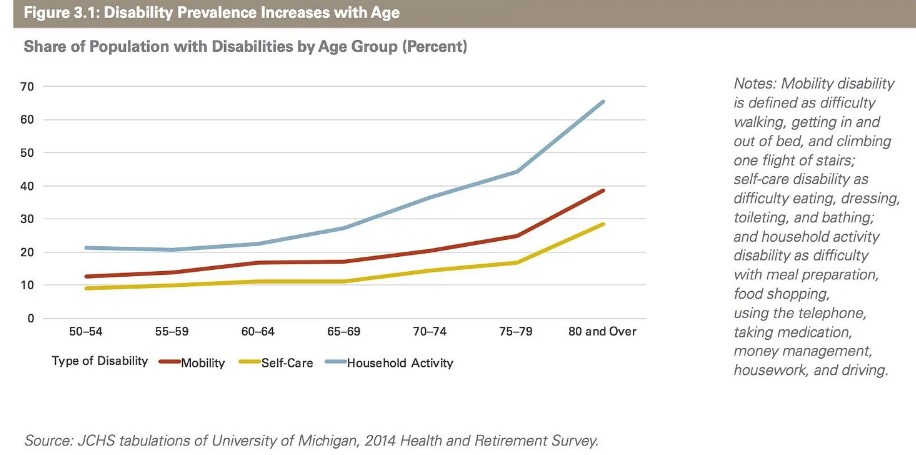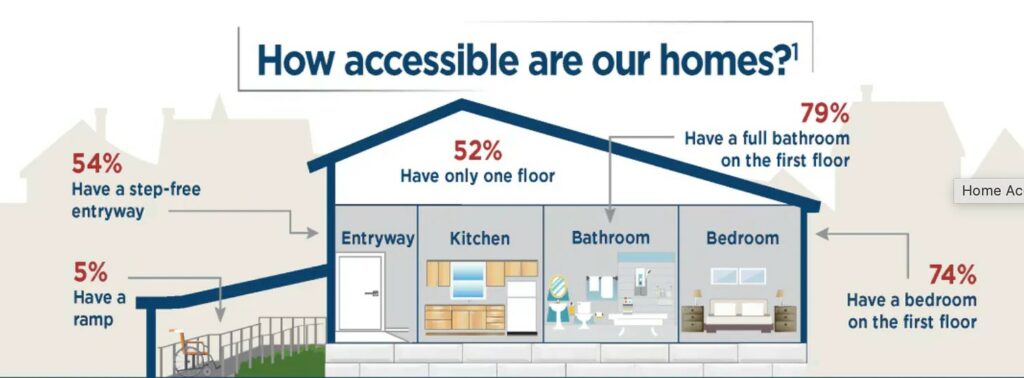Why fighting small apartment buildings is self-defeating and short-sighted
by Lloyd Alter
Llyod discusses the changing needs of the largest retirement population to be occurring in the next decade or baby boomers. Baby Boomers are on the verge of requiring smaller living spaces in close proximity to transportation, shopping, and healthcare. Easier and greater accessibility is paramount going forward.as they will not be as mobile as they once were. Cars may be out of the question.
Living quarters can be smaller as family has moved onward. Much of the infrastructure is still not in place or has to be refurbished to handle an older population. Open space for them to be outside needs to be planned. A community with less sprawl and greater mobility. Read on . . .
~~~~~~~~
People may not want neighborhood change, but they can’t avoid their own needs changing.
In Toronto where I live, there is a fight going on about rezoning what they call “major” streets to permit townhouses and rental buildings six stories high. A city councilor complains that people won’t like it.
“These are people that have worked all of their lives to pay the bills, to pay rent, to live in the neighborhoods that they dreamed and aspired to live in. And why should they accept change? Why should they accept change at this pace?”
The problem is that while they may not want their neighborhood to change, they themselves are changing as they age. Their needs are going to change. They are most likely baby boomers and the kind of housing that they are fighting is exactly the kind of housing that they are going to want or need in a few years.
In the US, according to the census, significant numbers of people have difficulty doing some pretty ordinary things, as basic as getting into their homes. 39% of households have at least one person with a disability or being over 65 (hardly a disability), but likely means that disabilities are coming soon.
There are 70 million baby boomers in North America who are now part of the “young-old” and can drive, climb stairs, and show up at public meetings to fight change. But in ten years, many will be part of the “old-old” who have trouble with household activities like driving or shopping.
Some real estate developers get this; this is a 70 unit “active adult” building in Northhampton, Mass built of mass timber to Passive House standards, which I wrote about on Treehugger. the developer notes, “the average man outlives his ability to drive by 7 years, the average woman by 10 years” and “walkable neighborhoods can be mobility enabling and health enhancing for millions.” It’s not a retirement home, but nice rental apartments where people can live without a car.
“With a mission to ‘transform how older Americans live, with new buildings in walkable, connected communities,’ Live Give Play has conceived a residential concept that supports healthy lifestyles (Live), community service (Give), and cultural engagement (Play) — all offered in an environmentally progressive structure and with attainable rents.”
Down the road from Toronto in Oakville, Ontario, the city council just voted 14-1 to reject upzoning to allow four-story buildings as part of a federal program to build “gentle density” housing; according to the Star, “after local residents expressed concerns the policies would change the character of established neighborhoods.”
“We don’t need to risk our neighbourhoods livability for the small amount in the housing accelerator fund grant,” said [Mayor] Burton at the council meeting where he brought in the motion to reject the gentle density policies.
“Thanks to our financial strength, we don’t have to accept a bad deal.”
And where are thse people going to live in ten years? Unlike these American sprawly houses, Oakville homes don’t have only one floor, don’t have full baths and bedrooms on the first floor, or have step-free entryways. Wouldn’t it be nice if they could stay in their own neighbourhood as they age, close to everything and everyone that they know? This is the kind of change people should be fighting, being forced to move far away because there is no suitable apartment accommodation nearby.
In a 2019 study, Neighborhood Defenders and the Capture of Land Use Politics Katherine Levine Einstein, David M. Glick, and Maxwell B. Palmerd discussed the politics of housing. Their research was in Massachusetts, but seems to apply to Toronto too:
Land use regulations can directly forbid the construction of high-density development and restrict the supply of housing. But, they may also reduce housing production by creating a political process that amplifies the voices of housing opponents. Land use regulations create opportunities for members of the public to have a say in the housing development process. Many types of housing proposals require public hearings which solicit input from neighborhood residents. This is by design. After the excesses of urban renewal, many localities turned to neighborhood-oriented processes as a check against developer dominance. But, like many participatory institutions, these land use forums may be vulnerable to capture by advantaged neighborhood residents eager to preserve home values, exclusive access to public goods, and community character.
And guess what?
We find that only 15 percent of meeting participants show up in support of the construction of new housing. Sixty-three percent oppose new development projects. Meeting commenters are also starkly unrepresentative of the mass public. Relative to Massachusetts voters, they are 25 percentage points more likely to be homeowners. They are also significantly older, more likely to be longtime residents, and male. They are nine percentage points more likely to be white.
I have been impressed that Toronto politicians are mostly supportive of more housing on major streets, and that the federal government has been promoting more “gentle density.” But it’s always a fight, it always takes years, and there are always expensive compromises. And it appears that the people who fight change are hardest are likely the ones that are going to need change the most.
In ten years, those old white men are likely going to look back and wish that building they fought had actually been built.






I see ads for low threshold tubs or tub to shower conversations, stair lifts and even one person elevators, all designed to allow older, less mobile adults stay in their homes.
The old old generation is already here, and has been quite a while if the number of ads are anything to go by.
In 10 years, the richer ones will be in a ranch style retirement community home in another state; the rest will either be in a nursing home because their kids don’t want to deal with them; or will have forgotten about their actions and complaining that they can’t find housing that suits them in the area.